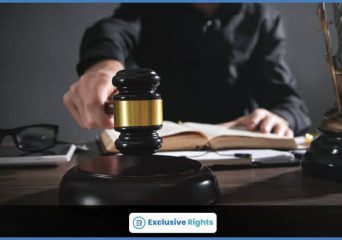
Table Of Contents
- What Does All Rights Reserved Mean?
- Origins of All Rights Reserved
- Purpose of the Phrase All Rights Reserved
- Copyright Protection Notice
- Ownership Establishment
- Legal Protection
- Deterrence
- International Recognition
- Customary Practice
- When To Use All Rights Reserved?
- Benefits Of Using All Rights Reserved
- How To Write All Rights Reserved?
- What Is The Duration Of Copyright Protection?
- All Rights Reserved Examples
- How to Write a Copyright Notice?
- Always Use the Copyright Symbol
- Write the “All Rights Reserved” Phrase
- Differences Between Copyrights and All Rights Reserved
- FAQs:
- 1: Should I Use All Rights Reserved?
- 2: Can I Use An Image That Says All Rights Reserved?
- 3: Is ‘All Rights Reserved’ Free?
- Wrap Up
What Does All Rights Reserved Mean?
What does all rights reserved mean? The acknowledgment of copyright obtaining in one State in accordance with its laws has the effect of an absolute right in all other States without the requirement for any further formality.
It means “all rights are reserved”.
In a nutshell, it means a statement indicating the reservation of the property right appears in work at all times.
This criterion is no longer in effect, and nothing analogous is there under US copyright rules.
The Berne Convention now includes all participants of the Buenos Aires Copyright Convention who must understand it.
Furthermore, copyright law may not make any formalities a requirement for copyright protection.
As a result, the phrase “all rights reserved” has no legal meaning. So, let’s get started on it without further ado.
What Does All Rights Reserved Mean?
The term “all rights reserved” appears on occasion in a copyright notice.
This implies that no one can utilize your work without first getting permission from you. This declaration is not required by law; therefore, omitting it has no legal consequences. The statement is redundant because people may not utilize copyrighted works without the consent of the copyright holder.
If you use the phrase “no rights reserved,” it signifies you’re permitting others to utilize your work. For example, when a work is produced for a charitable or public-interest purpose, and the author wants it to be available for general use by others, this is done.
Owners frequently use the term “All Rights Reserved” to signify that they reserve all of the rights given to them under copyright law. For example, photographers who upload their photos to photo-sharing sites like Shutterstock will frequently include an “All Rights Reserved” note in the title description.
However, copyright law does not mandate the use of this phrase. Hence failure to do so has no legal ramifications.
Origins of All Rights Reserved
The concept of All Rights Reserved started in the Buenos Aires Convention held in 1910. Article 3 of this Convention granted a copyright for signatory countries the reservation of a property right. Even though at first the concept of “All Rights Reserved” was not specified in a written format, ultimately it met its requirement.
In 1952, the UCC adopted the C symbol as an indicator for copyright protection. The symbol was first introduced in the 1954 amendment of the Copyright Act of 1909. Even though the Bern Convention rejected all its formality in Article 4. The authors after this, started looking for ways to protect their works that had already signed in with the Berne Convention. It was also specified that those who have signed into the Bern Convention, would not require anything extra for copyright. Even though not all signatories were members of Berne or the UCC, there was a particular request to join the UCC.
Purpose of the Phrase All Rights Reserved
The term “All Rights Reserved” has an essential purpose. Let’s keep reading to know what they are:
Copyright Protection Notice
The phrase helps in safeguarding any form of creative work that acts as a clear notice other than content to be protected under copyright law.
Ownership Establishment
This asserts a claim of ownership in copyright infringement. It also prevents others from claiming copyright and also forbids innocent infringement.
Legal Protection
By coming up with a visible copyright notice, the owner of the content can further strengthen their overall legal position when there’s a slight occurrence of copyright infringement. This is also a great instrument to prevent innocent infringement.
Deterrence
The display of notice can further discourage any unauthorized form of work. They signal the content creator about their vigilance which will also protect their rights.
International Recognition
Since the phrase is globally recognized, it acts as a reminder that the works of copyright are thereby safeguarded.
Customary Practice
This has now become a customary practice in the present day in the creative industry. It helps establish a standardized norm about any form of copyright protection.
When To Use All Rights Reserved?
What does all rights reserved mean? We have already clarified that it’s a copyright formality. However, you can use the “All rights reserved” remark as a copyright owner to signify that you maintain all copyright rights.
As a result, no portion of the work may be redone, distribution is not possible , or adoption can be done without your consent. Private usage and the right to quote from work are two legal exceptions so someone can do that without your permission even if your work says ‘all rights reserved.’
Because work is now automatically under protection by copyright, the notification is legally worthless. Despite this, many copyright owners continue to use it to underline their copyright rights.
You can choose a Creative Commons license if you want to be less rigorous and want to let people know right away that they can copy, publish, or alter your work and under what restrictions. More information on open-source licenses may be found at Licenses for open-source material.
Read More: 5 Forms Of The Hold Harmless Agreements And When To Use Them
Benefits Of Using All Rights Reserved
The significant benefit of including a copyright notice on your work is that you will be able to establish that you are the owner of the copyright.
You immediately own the copyright when you produce a book, compose music, take photographs, or make films.
Knowing that you are the owner isn’t always beneficial when you are proving that you are the owner if your copyrightable work has infringe case on it upon.
You must be able to establish that you own the copyright if you need to initiate a complaint against someone to have them stop violating your creation or sue for damages.
Registering your copyrightable work with the US Copyright Office is one approach to verifying ownership. Obviously, if your work is registered, the court will assume it is yours, and you will have met your burden of proof.
Another option to demonstrate that you own the work is to publish it with a copyright notice that informs people that it is your original content. Although the phrase “all rights reserved” is not applicable in your copyright notice, using it can undoubtedly assist.
How To Write All Rights Reserved?
What does all rights reserved mean? It means you own the right to your work. But, how do you write it? You may make a neat and effective copyright notice by writing the symbol С, then mention the year when your work was completed, the creator’s name, and the words “all rights reserved.”
In some situations, you may want to preserve some aspects of your work, in which case you can employ some reserved rights.
However, it may not be very effective if it is unclear what work is genuinely and whatnot.
If you don’t want to protect anything in your work but want to be explicit about it, you may say “no rights reserved,” which means you’re allowing others to use it.
What Is The Duration Of Copyright Protection?
Although you should get advice from an attorney or expert regarding your work, the US Copyright Office states that if the work were created after January 1, 1978, your copyright protection would endure for the rest of your life plus an extra 70 years.
The copyright for an anonymous work, a pseudonymous work, or a work created for hire lasts for 95 years from the year of first publication or 120 years from the year of creation, whichever comes first.
This implies that if you create copyrightable work, you can assure that you will protect the rights for the rest of your life plus another 70 years.
As a result, it’s advisable to include a copyright notice on all of your work in order to secure it as much as possible.
All Rights Reserved Examples
It may be helpful to look at an example to comprehend better the meaning of all rights reserved. Copyright owners use the expression “all rights reserved” to protect their work against infringement.
Unless otherwise stated, the United States Council for International Business owns the copyright to all information available on this website.
Any component of an actual work generation by the state or federal government officer or employee in the U.S. as a part of that individual’s official duties cannot claim as copyright.
USCIB retains all rights to its content, which you cannot copy, or download, distributed, published, or transmitted in any form or by any means without USCIB’s prior written consent.
How to Write a Copyright Notice?
If you’re wondering is there a specific way to use a copyright signal? To answer the question, yes there is. Here we will discuss the ways you can easily write a copyright notice:
Always Use the Copyright Symbol
Stating the most obvious phenomena in this case, always use the proper copyright symbol. It should be followed by the publication year and the name of your organization. If you want to abbreviate the term “copyright” you can do that by writing just “Copr”.
Write the “All Rights Reserved” Phrase
Needless to say, followed by the C symbol, always include the phrase “All Rights Reserved” to emphasize that you only retain exclusive rights to this work.
Differences Between Copyrights and All Rights Reserved
You might be wondering what are the differences between copyrights and all rights deserved. Let’s explain it to you in simple terms. Copyright protection is something that indicates the creator’s intention to have full ownership of the work. It defines the exclusive rights given only to the creator. On the other hand, “All Rights Reserved” is just a mere notice emphasizing the creator’s ownership and control over their work.
FAQs:
1: Should I Use All Rights Reserved?
Ans: This declaration is not applicable by law; therefore, omitting it has no legal consequences. The statement is redundant because people may not utilize copyrighted works without the consent of the copyright holder.
2: Can I Use An Image That Says All Rights Reserved?
Ans: If the photo states that all rights are reserved, you must contact the photographer to obtain permission to use it.
You won’t be able to use it if they refuse to authorize you.
The sole practical use of this statement serves as a warning. It means the author is aware that he has copyright and intends to maintain it.
3: Is ‘All Rights Reserved’ Free?
Ans: By default, all rights are retained under copyright law; nothing is possible with copyright work without prior authorization.
The phrase was under the Buenos Aires Copyright Convention of 1910. Some rights reserved is a phrase applicable for Creative Commons to emphasize their more liberal approach to copyright.
Wrap Up
All rights reserved mean the term suggests that the copyright holder does not wish to relinquish any of his exclusive copyright rights.
Only members of the Buenos Aires Copyright Convention will face the impact. Even though the term “all rights reserved” no longer has any legal meaning, it is nonetheless is applicable right now.
So, if you have any further questions on this topic, you can let us know in the comment section below.
Read Also:












